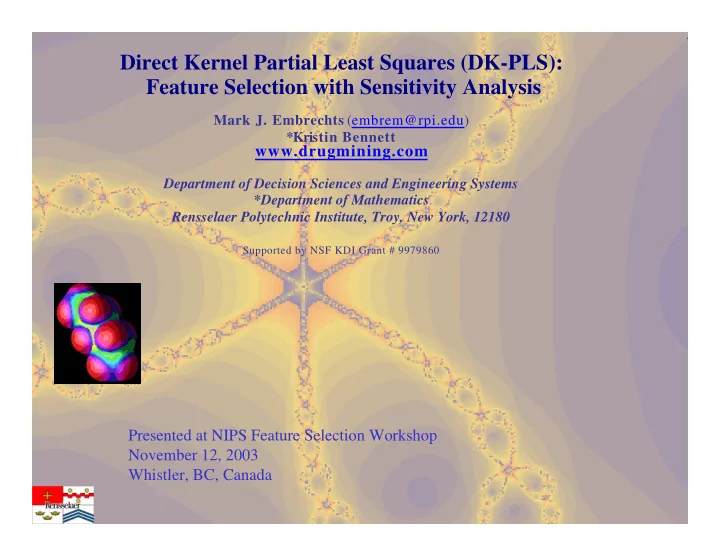

Direct Kernel Partial Least Squares (DK-PLS): Feature Selection with Sensitivity Analysis Mark J. Embrechts (embrem@rpi.edu) *Kristin Bennett www.drugmining.com Department of Decision Sciences and Engineering Systems *Department of Mathematics Rensselaer Polytechnic Institute, Troy, New York, 12180 Supported by NSF KDI Grant # 9979860 Presented at NIPS Feature Selection Workshop November 12, 2003 Whistler, BC, Canada
Outline • PLS - Please Listen to Svante Wold - Partial-Least Squares - Projection to Latent Structures • Kernel PLS (K-PLS) - cfr Kernel PCA - Kernel makes PLS model nonlinear - Regularization by selecting small number of latent variables • Direct Kernel PLS - Direct Kernel Methods - Centering the Kernel • Feature Selection with Analyze/StripMiner - Filters: Naïve feature selection: drop “cousin features” - Wrappers: Based on sensitivity analysis � Iiterative procedure � Training set for feature selection used in bootstrap mode
Kernel PLS (K-PLS) • Direct Kernel PLS is PLS with the kernel transform as a pre-processing step - K-PLS � “better” nonlinear PLS PLS � “better” Principal Component Analysis (PCA) for regression - • K-PLS gives almost identical (but more stable) results as SVMs - Easy to tune (5 latent variables) - Unlike SVMs there is no patent on K-PLS • K-PLS transforms data from a descriptor space to a t-score space t 2 t 1 d 3 d 1 y d 2
Implementing Direct Kernel Methods Linear Model: - PCA model - PLS model - Ridge Regression - Self-Organizing Map . . .
Scaling, centering & making the test kernel centering consistent Centered Mahalanobis-scaled Kernel Transformed Training Data Direct Kernel Training Data Training Data (Training Data) Mahalanobis Vertical Kernel Scaling Factors Centering Factors Centered Mahalanobis-scaled Kernel Transformed Test Data Direct Kernel Test Data Test Data (Test Data)
Docking Ligands is a Nonlinear Problem
Electron Density-Derived TAE-Wavelet Descriptors Surface properties are encoded on 0.002 e/au 3 surface • Breneman, C.M. and Rhem, M. [1997] J. Comp. Chem. , Vol. 18 (2), p. 182-197 • Histograms or wavelet encoded of surface properties give Breneman’s TAE property descriptors • 10x16 wavelet descriptore Histograms PIP (Local Ionization Potential) Wavelet Coefficients
Data Preprocessing • Data Preprocessing for Competition - data centering - to normalize or not? (no) • General Data Preprocessing Issues: - extremely important for the success of an application - if you know what the data are you can do smarter preprocessing - drop features with extremely low correlation coefficient and sparsity - outlier detection and cherry picking? Acknowledgment: C. Breneman
Feature Selection • Why feature selection - explanation of models - simplifying models - improving models • Naïve feature selection (filters): - drop all features that are more than 95% correlated but one - drop features with less than 1% sparsity (binary features) - drop features with extremely low correlation coefficient • Sensitivity analysis for feature selection (wrappers) - make model (e.g., SVM, K-PLS, neural network) - keep features frozen at average - tweak all features and drop 10% of the least sensoitive features � boostrap mode � random gauge parameter • Note: For most competition datasets we could find an extremely small feature set that works perfect on training date, but did not generalize to validation data.
Bootstrapping: Model Validation DATASET Training set Test set Bootstrap sample k Predictive Model Training Validation Learning Tuning / Prediction Model Prediction
Caco-2 – 14 Features (SVM) � Each star represents a descriptor � Each ray is a PEOE.VSA.FNEG a.don DRNB10 BNPB31 separate bootstrap � The area of a star represents the relative importance of that descriptor ABSDRN6 ABSKMIN KB54 FUKB14 � Descriptors shaded cyan have a negative effect � Unshaded ones PEOE.VSA.FPPOS SIKIA SMR.VSA2 SlogP.VSA0 have a positive effect • Hydrophobicity - a.don • Size and Shape - ABSDRN6, SMR.VSA2, ANGLEB45 Large is DRNB00 ANGLEB45 bad. Flat is bad. Globular is good. • Polarity – PEOE.VSA...: negative partial charge good.
Conclusions • Thanks to competition organizers for a challenging and fair competition • Congratulations to the winners • Congratualtions to those who ranked in front of me
Recommend
More recommend